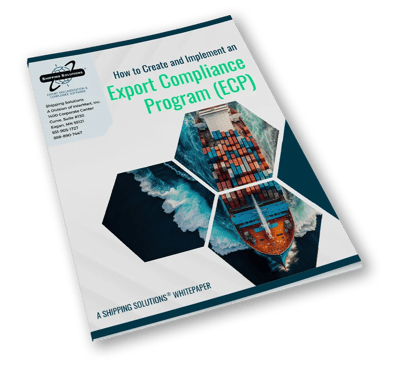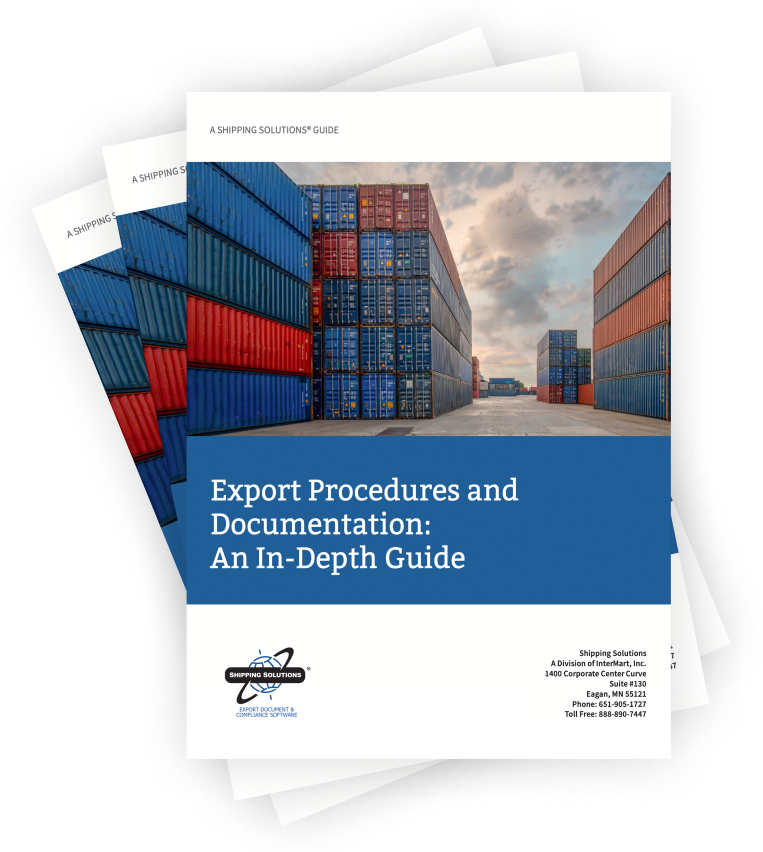The International Trade Blog Export Compliance
A Glossary of International Shipping Terms
On: March 3, 2025 | By:  Arnesh Roy |
86 min. read
Arnesh Roy |
86 min. read
 Shipping products seems simple, right? You simply package the product and send it to your customer. But did you know there are different types of shipment?
Shipping products seems simple, right? You simply package the product and send it to your customer. But did you know there are different types of shipment?
Depending on the size of your shipment, it may be considered parcel, less-than-load (LTL) or a full truckload (FTL) shipment. Your shipment may be too small for certain carriers, or conversely, if you have a large shipment, you may have to rely on a carrier certified to ship large containers. There are also unique considerations depending on the mode of transport—whether you’re shipping via air, sea, road or rail.
Scores of exporters who use Shipping Solutions Export Documentation and Compliance Software have told us that the wide variety of terms that relate to the process of moving goods through a supply chain seem overwhelming. But understanding the different types of shipment and related terms is crucial to ensure your goods get shipped on time, within compliance and in good shape.
That's why we've provided this glossary of international shipping terms.
A | B | C | D | E | F | G | H | I | J | L | M | N | O | P | Q | R | S | T | U | V | W

ACE
The Automated Commercial Environment is the online web portal used to report data to the Automated Export System (AES) for exports leaving the United States, and also for customs filing for imports entering the United States.
ACE—Authorized Cybersecurity Exports
Export license exception ACE permits the export, re-export and transfer (in-country), including deemed exports and re-exports, of designated "cybersecurity items" to authorized end users and destinations. This exception supports cybersecurity activities and incident response while restricting access to sensitive government end users and applications that may pose national security concerns. Learn more: What You Need to Know about Export License Exceptions.
ACM—Advanced Compute Manufacturing
This license exception allows for the export, re-export or transfer (in-country) of advanced computing chips, without an authorization, for the purposes of development, production and storage of these chips, except to arms-embargoed countries. Learn more: What You Need to Know about Export License Exceptions.
Advance Payment
See Cash in Advance.
AES
The Automated Export System is used by the U.S. government to collect data on exports. This data is called Electronic Export Information (EEI), and in many cases, exporters are legally required to file the EEI through AES for each shipment. The U.S. Census Bureau uses this data to calculate trade statistics such as gross domestic product (GDP), while U.S. Customs and Border Protection (CBP) uses it to make sure exporters are following U.S. export regulations. See also: Filing through AESDirect: 20 Terms Exporters Need to Know.
Aggregate Shipment
Multiple shipments—from different sellers to a single consignee—that are consolidated by the carrier into a single shipment.
AGR—Agricultural Commodities
License exception AGR permits the export of agricultural commodities to Cuba, as well as the re-export of U.S.-origin agricultural commodities to Cuba, provided the transaction meets all of the criteria laid out in Part 740.18. Exporters must notify BIS before any export or re-export under license exception AGR. Learn more: What You Need to Know about Export License Exceptions.
AIA—Artificial Intelligence Authorization
This export license exception allows for the export, re-export or transfer (in-country) of advanced computing chips, without an authorization, to a set of allies and partners. Learn more: What You Need to Know about Export License Exceptions.
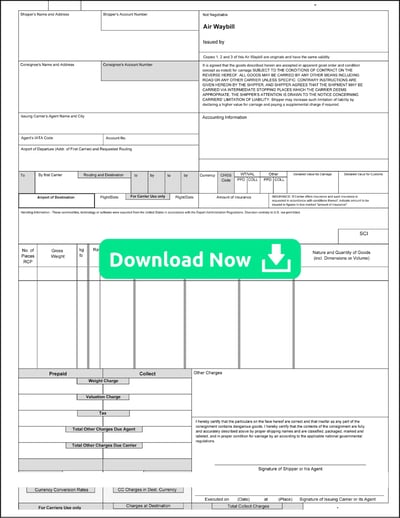 Air Waybill (AWB)
Air Waybill (AWB)
The AWB is a document that controls the routing of an exporter’s cargo while it is in the hands of the air carrier or a consolidator. It is a contract for carriage; however, it cannot be negotiated.
ALADI
The Latin American Integration Association (ALADI) is an international association of Latin American countries. Its function in Latin America is comparable to the function of the former European Economic Community—which has now become embedded in the framework of the European Union—in Europe. The goal of ALADI is to harmonize trade across the member states. There are currently 13 member countries representing a population of more than 500 million people. ALADI has its own commodity classification system similar to the global Harmonized System (HS).
Alongside
Refers to the side of a ship. Goods delivered alongside are placed on the dock or barge within reach of the ship’s rigging so it can be easily loaded onto the ship. For example, it’s used in the Incoterms 2020 trade term Free Alongside Ship.
APP—Computers Adjusted Peak Performance
License exception APP authorizes exports, re-exports and transfers (in-country) of computers, including “electronic assemblies” and specially designed components therefor controlled by ECCN 4A003 exported or reexported separately or as part of a system for consumption in Computer Tier countries as listed in Part 740.7. When evaluating your computer to determine license exception APP eligibility, use the APP parameter to the exclusion of other technical parameters in ECCN 4A003.
License exception APP also authorizes exports of technology and software controlled by ECCNs 4D001 and 4E001 specially designed or modified for the “development,” “production,” or “use” of computers, including “electronic assemblies” and specially designed components therefor classified in ECCN 4A003 to Computer Tier countries. Learn more: What You Need to Know about Export License Exceptions.
Antidiversion Clause
See Destination Control Statement.
Antidumping Duty
A special duty imposed by a country's customs authority to offse the price effect of dumping that has been determined to be materially harmful to domest producers.
Apparent Good Order
When freight appears to be free of damage after being assessed it is said to be in apparent good order.
APR—Additional Permissive Re-Exports
Export license exception APR authorizes re-exports of two categories: reexports from Country Group A:1 and Hong Kong; as well as reexports to and among specific countries as detailed in Part 740.16. Learn more: What You Need to Know about Export License Exceptions.
Arbitration
A process for resolving a dispute or a grievance outside the court system by presenting it to an impartial third party or panel for a decision that may or may not be binding.
Arrival Notice
Notification provided by the carrier when a shipment has arrived to the consignee or notify party.
Astern
Means either "behind a ship" or "to move a ship in reverse direction."
ATDNSHINC
Stands for Any Time, Day or Night, Sundays and Holidays Included, referring to when a vessel will operate.
Athwartships
A direction across the width of a ship.
Audit
A thorough examination of a business’s processes to determine if the business is compliant with a particular set of standards. A government agency may audit a company’s processes or records as part of an investigation related to a potential compliance violation. In some industries, companies must pass periodic government audits to maintain their authorizations. Companies may also conduct internal audits (self-audit), or hire a third party to audit their processes. The Bureau of Industry and Security (BIS), the export control arm of the U.S. Department of Commerce, recommends that U.S. exporters periodically self-audit to ensure compliance procedures are working properly and are up-to-date with regulation changes. Auditability refers to the capacity of an auditor to audit an auditee. Sloppy record-keeping lowers auditability. An audit trail is a system (physical or electronic) that keeps track of business processes. See also: 4 Reasons to Audit Your Company’s Export Procedures.
Audit Trail
A system that stores and maintains records of business processes. With regards to exporting, companies are strongly encouraged to maintain an audit trail documenting their compliance screenings in order to demonstrate due diligence in case of an audit. Having an audit trail may protect your company from fines or penalties in the case of an export compliance violation.
Australia-United States Free Trade Agreement (AUSFTA)
A bilateral free trade agreement between the United States and Australia that implements a wide variety of trade policies designed to mutually benefit both countries. Modeled off of the North American Free Trade Agreement (NAFTA), the AUSFTA came into effect on Jan. 1, 2005. One of the primary goals of this agreement is to increase market access for Australian companies exporting to the United States.
Automatic Identification System (AIS)
A satellite system used by ships and vessel tracking service (VTS) to identify and locate ships.
AVS—Aircraft, Vessels, and Spacecraft
Export license exception AVS authorizes departure from the United States of foreign registry civil aircraft on temporary sojourn in the United States and of U.S. civil aircraft for temporary sojourn abroad; the export of equipment and spare parts for permanent use on a vessel or aircraft; exports to vessels or planes of U.S. or Canadian registry and U.S. or Canadian Airlines’ installations or agents; the export or reexport of cargo that will transit Cuba on an aircraft or vessel on temporary sojourn; and the export of spacecraft and components for fundamental research. Generally, no License Exception symbol is necessary for export clearance purposes; however, when necessary, the symbol ‘‘AVS’’ may be used.
Backhaul
Cargo carried on a return journey.
BAG—Baggage
Export license exception BAG authorizes individuals leaving the United States either temporarily (i.e., traveling) or longer term (i.e., moving) and crew members of exporting or re-exporting carriers to take to any destination, as personal baggage, the classes of commodities, software and technology described in Part 740.14. This part also lists special provisions including those related to unaccompanied baggage (baggage that is not being transported on the same carrier as the baggage owner), software, technology, shotguns, and shotgun shells. Learn more: What You Need to Know about Export License Exceptions.
Balloon Freight
Freight that is low weight but high volume (light but bulky).
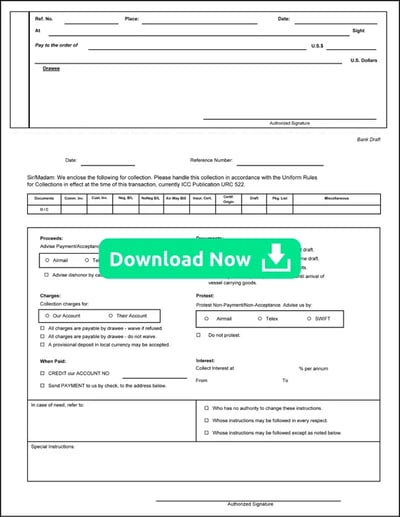 Bank Draft
Bank Draft
A financial instrument provided by a bank and drawn on another bank. See also: Understanding Bank Drafts: Sight Draft versus Time Draft.
Beam
The width of a ship.
Beneficiary
The party that receives payment.
Bilateral
A bilateral agreement is one in which both parties agree to provide something for the other.
Bill of Lading
A document issued by a carrier or their agent acknowledging receipt of cargo for shipment. Often abbreviated as BOL, BoL, B/L or BL. If there were no issues with the cargo stated on the BOL, it is said to be a clean bill of lading. See also: What Is a Bill of Lading: 3 Things You Need to Know.
Bill of Sale
A document that confirms transfer of goods in exchange for money.
Bill-To Party
The party paying for goods or services in a transaction.
BIS
The Bureau of Industry and Security, an agency within the U.S. Department of Commerce tasked with enforcing the Export Administration Regulations (EAR).
Blocking or Bracing
Wood or metal supports used to secure cargo while in transit. Also called dunnage.
Block Stowage
Loading cargo close together to minimize movement of goods while in transit.
Bolster
A piece of equipment attached to a chassis or railcar to secure the container.
Bond Port
The initial port of entry where a vessel transporting goods first arrives at a country.
Booking
Arrangements made with a carrier for the movement of cargo; space reservation.
Bow
The front of a vessel.
Broken Stowage
Empty space in a container not occupied by cargo.
Bulk Cargo
Cargo that is shipped loose as opposed to being shipped in packages or containers. Grain and coal are examples of goods usually shipped as bulk cargo.
Bull Ring
A device attached to the floor of a container which is used to secure cargo.
Cabotage
Transport of goods between two places in the same country by a transporter from another country.
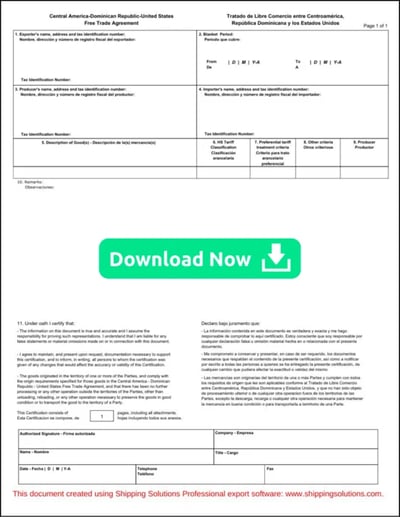 CAFTA-DR
CAFTA-DR
The Central America Free Trade Agreemen-Dominican Republic (CAFTA-DR) is a free trade agreement between the United States and several countries, including the Dominican Republic, as well as the Central American nations Costa Rica, El Salvador, Guatemala, Honduras and Nicaragua. The U.S. Senate approved the CAFTA-DR on June 30, 2005. The agreement includes a most favored nation (MFN) clause, which requires that service suppliers in one country may not be treated any less favorably than suppliers in other countries that are part of the agreement. It also includes provisions that protect companies in member countries from unfair investment practices, protect intellectual property rights and establish procedures for dispute resolution.
Canada Customs Invoice
A Canada Customs Invoice is a special type of invoice required for U.S. exports to Canada in the following situations: 1.) The shipment is valued at over $2,500 CAD. 2.) The shipment is not classified under HTSUS Chapter 9810. 3.) The shipment is subject to duties and sales taxes. See our article: What You Need to Know about the Canada Customs Invoice.
Cargo
Any goods being transported, regardless of the mode of transport.
Cargo Declaration
Information submitted prior to, upon arrival or upon departure of an international shipment required by a country’s customs authority.
Cargo Manifest
A document detailing the cargo carried on a ship, often provided to a customs authority.
CARICOM
An intergovernmental organization of 15 Caribbean countries whose goal is to promote economic integration and cooperation between member states. The resulting free trade zone is called the Caribbean Common Market.
Carnet
A document permitting the holder to temporarily send goods to certain foreign countries for display or demonstration purposes without having to pay duties. See also: What is an ATA Carnet?
Carrier
A carrier is a party that transports goods for another person or company and is responsible for any possible loss of or damage to the goods during transport. A common carrier provides transportation services to the public in return for compensation. A contract carrier provides this service under special contracts, often for government clients.
Cash in Advance
Payment from a foreign customer to a U.S. exporter prior to actually receiving the exporter's products. It is the least risky form of payment from the exporter's perspective. See also, Methods of Payment in International Trade: Cash in Advance.
Cash on Delivery (COD)
The sale of goods in which payment is made upon delivery rather than in advance.
CBP
Customs and Border Protection, part of the Department of Homeland Security, is the agency within the U.S. government tasked with controlling the flow of people and goods into and out of the country, and with enforcing import and export regulations.
CCC Mark
A label indicating cargo conforms to standards established by the Chinese government.
CCD—Consumer Communications Devices
License exception CCD authorizes the export or re-export of commodities and software to Cuba or Sudan subject to the requirements stated in Part 740.19. Commodities that may be eligible for this license exception include consumer computers, mobile phones, televisions, radios and related equipment. Learn more: What You Need to Know about Export License Exceptions.
CCL
The Commerce Control List is a list of dual-use items (items that have both a commercial application as well as a potential military application) published as part of the U.S. Department of Commerce’s Export Administration Regulations (EAR). Each item on the CCL is identified with an Export Control Classification Number (ECCN). Knowing the right ECCN for your product plays a role in determining if you need an export license.
CE Mark
A label indicating cargo conforms to standards established by the European Union.
Certificate of Conformity (CoC)
A document issued by an authorized party that states that a particular product meets relevant standards of quality and performance.
Certificate of Free Sale
This document indicates a particular product is marketed in the United States or is eligible for export, and that the particular manufacturer has no unresolved enforcement actions pending before or taken by the U.S. Food and Drug Administration (FDA). It is often used when exporting to countries whose regulatory agencies are not as well-developed as the United States’ FDA.
Certificate of Inspection
A document certifying that merchandise is in good condition immediately prior to being shipped.
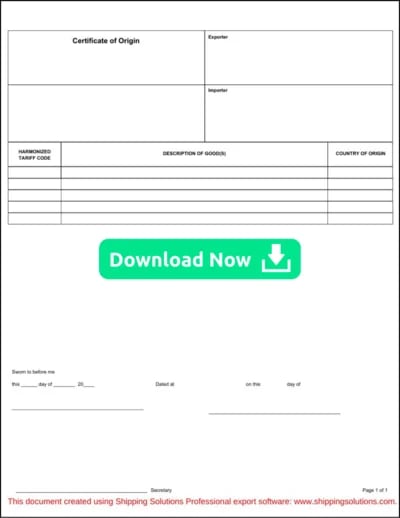 Certificate of Origin (COO)
Certificate of Origin (COO)
A document certifying where goods were originally made. A COO specific to a particular free trade agreement may be used to claim preferential duty treatment. A generic certificate of origin may be requested by the customs authority of the country of import, in which case the COO must be stamped by a chamber of commerce.
CFR (Cost and Freight)
CFR is an Incoterm for sea and inland waterway transport. Seller clears the goods for export and delivers them when they are on board the vessel at the port of shipment. Seller bears the cost of freight to the named port of destination. Buyer assumes all risks for the goods from the time the goods have been delivered on board the vessel at the port of shipment.
CFR
The Code of Federal Regulations is the codification of rules and regulations published in the U.S. Federal Register.
Chamber of Commerce
An association of businesses that may serve several functions, including advocating or lobbying for their member companies, organizing business-related programming and events in their communities, and, perhaps most relevant for exporters, providing document certification services. See also: The Chamber of Commerce and Export Documents: The Certificate of Origin.
Chamber Stamp
Certain documents (such as certificates of origin) require a stamp from a U.S. chamber of commerce to be considered valid. The process of stamping the document is called chamberization, and a document that has received a chamber stamp is said to be chamberized.
Chapter Notes
Some parts of the Harmonized System (HS) nomenclature include notes. These may be divided into Section Notes, Chapter Notes and Subheading Notes. These notes hold legal weight as an integral part of the HS. Not to be confused with Explanatory Notes. See our article: When Classifying Parts Using HTS Codes, Read the Notes!
Chassis
The base frame of a wheeled vehicle, used to secure a container prior to movement.
Chock
Material (often wood) placed next to cargo to prevent excessive movement of the cargo during transit in order to avoid damage.
CIF (Cost, Insurance and Freight)
CIF is an Incoterm for sea and inland waterway transport. Seller clears the goods for export and delivers them when they are on board the vessel at the port of shipment. Seller bears the cost of freight and insurance to the named port of destination. The seller is required to purchase the minimum level of insurance under Clause C of the Institute Cargo Clauses. Buyer is responsible for all costs associated with unloading the goods at the named port of destination and clearing goods for import. Risk passes from seller to buyer once the goods are on board the vessel at the port of shipment.
CIP (Carriage and Insurance Paid To)
CIP is an Incoterm for any mode of transport. Seller clears the goods for export and delivers them to the carrier or another person stipulated by the seller at a named place of shipment, at which point risk transfers to the buyer. Seller is responsible for the transportation costs associated with delivering goods and procuring insurance coverage to the named place.
CL
Abbreviation for carload or containerload.
Claim
In the context of logistics, a claim is a demand made by a customer to a transportation company for payment in order to compensate for loss or damage of goods.
CM and cm
CM (uppercase) stands for “cubic meters,” while cm (lowercase) stands for “centimeters.”
Code of Federal Regulations (CFR)
The codification of the general and permanent rules published by the U.S. Office of the Federal Register; the place where all U.S. federal regulations are published. 15 CFR (Title 15 of the CFR) is the section on Commerce and Foreign Trade.
Commerce Country Chart
Part of the Export Administration Regulations (EAR), which helps exporters determine if they need to apply for an export license in order to ship a particular product to a particular country.
Commercial Invoice
A fundamental document for an international transaction with details including what goods are being shipped, who is the shipper and who is the ultimate consignee. Serves as the basis for all other documents related to the shipment.
Commodity
Any commercial good that is shipped.
Common law
Law that derives authority from precedent, custom and usage rather than from statutes, particularly regarding the laws of the United States, the United Kingdom and countries formerly part of the British Empire.
Compliance
In the context of international shipping, being compliant or maintaining compliance means that the company in question is following all applicable laws and rules which govern their shipments. In this context, the more specific terms regulatory compliance or trade compliance may be used to differentiate from other uses of the term, as the word compliance has other meanings in other contexts such as in the fields of medicine and psychology. A business practice that goes against specific laws is termed a compliance violation. See also: What to Do When You Encounter Export Violations.
Concealed Loss/Concealed Damage
Shortage of or damage to goods shipped that is not immediately evident upon delivery.
Confirming House
A company based in a foreign country that acts as a foreign buyer's agent and places confirmed orders with U.S. exporters. The confirming house guarantees payment to the exporters.
Connecting Carrier
A carrier which acts as an intermediary between two or more other carriers.
Consignee
The person or place to whom a shipment will be transferred. The ultimate consignee is the final recipient of the goods, while an intermediate consignee takes possession of the goods for a portion of the time that they are in transit.
Consignment
A shipment of goods to a consignee.
Consignor
Refers to the exporter or shipper from which the goods originate.
Consolidation
When cargo from multiple shippers is combined in a single container.
Consul
A government official residing in a foreign country who represents the interests of their home country.
Consular Invoice
A document required by some countries' customs authorities that describes the shipment of goods and shows information like the consignor, consignee and the value of the shipment. These invoices are certified by the consular official of the foreign country stationed in the United States. These are often obtained along with a certificate of origin stamped by a chamber of commerce.
Consumption Entry
When goods are imported into the United States without any time or use restrictions. The official U.S. Customs and Border Protection (CBP) website states that about 95% of all imports fall into this category.
Container
A truck trailer loaded with cargo that can be detached for loading onto a vessel or railcar. Different types of containers exist for different shipping needs. For example, a container may be ventilated, refrigerated, insulated, dehumidified or equipped with special devices used to secure certain types of cargo. A container shipment is a large shipment, typically over 20,000 pounds.
Container Load
A load large enough in volume or weight to fill a container.
Container Manifest
A document stating the contents of a container, its point of origin and point of destination. Vessels may be required by law to produce a manifest for every container being transported.
Contraband
Prohibited cargo such as illegal drugs or unauthorized weapons.
Contract
A legally binding agreement between two or more parties.
Copyright
Protection granted to the authors and creators of literary, artistic, dramatic and musical works as well as sound recordings and certain other intellectual works. A computer program, for example, is considered a literary work in the United States and some other countries. See also, 10 Terms Exporters Should Know about Intellectual Property.
Countervailing Duties
Additional duties imposed by an importing country to offset government subsidies in an exporting country when the subsidized imports cause material injury to domestic industry in the importing country. See also, Anti-Dumping Duties and Countervailing Duties: An Overview.
Country of Origin
Where an item was made, mined, grown, manufactured or substantially transformed. Most items imported into the United States require a country of origin marking, also known as C/O marking, with the exception of items on the J-List (see J-List).
CPT (Carriage Paid To)
CPT is an Incoterm for any mode of transport. Seller clears the goods for export and delivers them to the carrier or another person stipulated by the seller at a named place of shipment. Seller is responsible for the international transportation costs associated with delivering goods to the named foreign place of destination. The transfer of risk, on the other hand, transfers from the seller to the buyer as soon as the goods are delivered to the international carrier. That means the buyer assumes the risk of loading the goods on the carrier and during the international transport of the goods.
C-TPAT
U.S. Customs and Border Protection established Customs-Trade Partnership Against Terrorism in November 2001 as a voluntary partnership to help ensure supply chain security. Meeting C-TPAT standards enables faster processing through customs inspections and formalities.
Cu.
Abbreviation for “cubic” used when describing measurements of volume.
Cube Out
Refers to when a container or vessel has reached its volumetric capacity before reaching its weight capacity.
Customhouse
A government office where duties are paid and import and export paperwork are filed.
Customs
A customs authority, or customs for short, refers to the agency within a government that is responsible for collecting duties and enforcing import and export regulations.
Customs-Bonded Warehouse
A warehouse authorized by customs to receive duty-free goods.
Customs Broker
An individual or organization who helps a shipper navigate customs requirements.
Customs Clearance
The process in which a customs authority assesses a shipment being imported in their country in order to ensure compliance with their country’s import regulations. A shipment that has been approved by the customs authority and allowed to enter the commerce of their country is said to have cleared customs.
Customs Declaration
A document that traditionally accompanies exported goods bearing information like the nature of the goods, their value, the consignee, and their ultimate destination.
Customs Entry
Also called Entry Summary or Form 7501, is a document that provides U.S. Customs and Border Protection (CBP) with details about a shipment being imported into the United States, such as value, classification and origin. CBP uses the form to calculate duties owed.
Customs Invoice
A document required by a country’s customs authority, which serves the same purpose as a standard commercial invoice but also contains additional information such as a certificate of origin.
Customs of the Port (COP)
A phrase referring to local rules and practices that may impact a shipment.
Customs Value Only
Some shipments involve no actual monetary transaction between the exporter and the ultimate consignee, such as shipments for repair under warranty, or shipments of items used for display at trade shows. These shipments are still subject to duties and taxes, and exporters must list the monetary value of the items in the shipment on the customs invoice to enable the customs authority in the country of import to assess how much duty the importer must pay. In these cases, the exporter should include a customs value only statement on the invoice.
Cut-Off Time
The latest time cargo may be delivered to a terminal for loading.
Dangerous Goods
A product may be considered a dangerous good if it is corrosive, flammable, poisonous, toxic, explosive, etc. Shipping dangerous goods may require special documentation or packaging to ensure safety. See also: Hazardous Materials vs. Dangerous Goods: What's the Difference
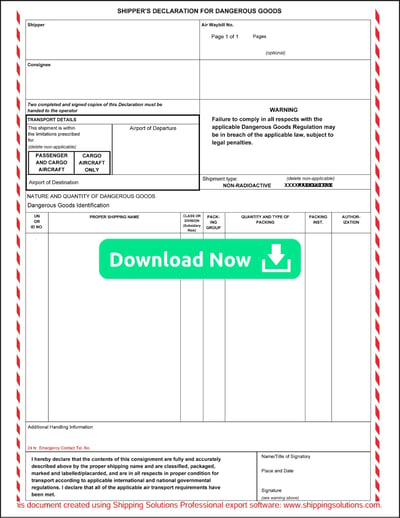 Dangerous Goods Declaration
Dangerous Goods Declaration
A document required when shipping dangerous goods (also known as hazardous materials or HazMat). There are two main versions: the DG IATA form for air transport and the DG IMO form for inland and ocean transport. There is a third version specifically for shipments of lithium batteries, which is called a Lithium Battery Declaration. See our article: What You Need to Know about Shipping Dangerous Goods.
DAP (Delivered at Place)
DAP is an Incoterm for any mode of transport. Seller clears the goods for export and bears all risks and costs associated with delivering the goods to the named foreign destination not unloaded. DAP means the buyer is responsible for all costs and risks associated with unloading the goods and clearing customs to import the goods into the named country of destination.
Date Draft
A document used when the exporter extends credit to the buyer. It specifies a date when the payment is due rather than a time period as with a Time Draft.
Destination Control Statement
A legal statement put on an export invoice that specifies that the goods are to be transferred to the ultimate consignee and no other party. Diversion to other countries or parties without prior authorization is a violation of U.S. law. Also called an anti-diversion clause.
DDTC
Directorate of Defense Trade Controls (DDTC) is the government agency within the U.S. Department of State tasked with enforcing the International Traffic in Arms Regulations (ITAR), which regulate the export of space- and defense-related products.
D&H
Abbreviation for “dangerous and hazardous” cargo.
DBA
Stands for “doing business as,” used to specify that a company is doing business under a certain registered name.
Direct Exporting
The sale by an exporter directly to an importer located in another country.
DDP (Delivered Duty Paid)
DDP is an Incoterm for any mode of transport. The seller bears all risks and costs associated with delivering the goods to the named place of destination ready for unloading and cleared for import.
Deconsolidation Point
Location where cargo is separated in preparation for delivery.
Deemed Export
Transmission of controlled technology, source code or information to a foreign national at home or abroad. Export regulations apply to deemed exports as well. See also: Deemed Exports: Exporting Without Shipping a Product.
Delivery Receipt
A document signed and dated by a consignee or their authorized agent confirming receipt of goods and stating the condition of the goods upon delivery.
Demurrage/Detention
Demurrage is a charge to be paid by a shipper or consignee to the carrier as penalty for delaying the carrier’s cargo beyond the allowed free time. Detention is the same as demurrage except that instead of applying to delays in cargo, detention applies to delays in equipment.
Denied Party Screening
Also called restricted party screening or trade party screening, denied party screening is the process of screening potential customers, partners or vendors against denied party lists. These are lists of individuals or organizations that a government has identified as parties that one can’t do business with and that one may be penalized for doing business with. See also: Export Compliance: Understanding Restricted Party Screening.
Destination Control Statement
A legal statement put on a shipping document that specifies that the goods are to be transferred to the ultimate consignee and no other party. Diversion to other countries or parties without prior authorization is a violation of U.S. law. See also: What Is the Destination Control Statement and Why Should It Be on Your Commercial Invoice?
Discrepancy
When documents presented do not conform to the requirements of the letter of credit. Banks will not accept letters of credit that have discrepancies.
Distribution Center
A location created for circulation of products into a specific market. This may or may not be a part of the same company that uses it to move their products to market. A company that specializes in distributing other companies’ products is called a distributor. See our article: Sealing the Deal: Selecting the Right Distributor for Your Exports.
Distributor
A merchant in a foreign country who purchases goods from a U.S. exporter and resells them for a profit. The foreign distributor generally provides support and service for the product, relieving the U.S. exporter of these responsibilities.
Diversion
Diversion refers either to 1) a change made to the route of a shipment or to the route of the entire vessel or 2) the transfer of goods from the intended end-user to some other party.
Dock
For road transportation, a platform from which trucks are loaded and unloaded. For sea transportation, a cargo handling area adjacent to the shoreline where a ship ties up.
.webp?width=400&height=519&name=Dock%20Receipt%20(1).webp) Dock Receipt
Dock Receipt
A document used to acknowledge receipt of cargo. Provides the framework for the preparation of an ocean bill of lading.
Documentary Letter of Credit
A document used to protect the interests of both buyer and seller. A letter of credit requires that payment be made on the presentation of specified documents to a lender conveying the title and indicating the specific steps have been taken. See also, Methods of Payment in International Trade: Letters of Credit.
DOT
U.S. Department of Transportation, a U.S. agency within the executive branch that oversees transportation in the U.S.
DPU (Delivered at Place Unloaded)
DPU is an Incoterm for any mode of transport. Previously named Delivered at Terminal (DAT), this Incoterm has been renamed Delivered at Place Unloaded (DPU) because the buyer and/or seller may want the delivery of goods to occur somewhere other than a terminal. DPU is very similar to DAP except that the seller must pay for unlading the goods. Like DAP, the seller clears the goods for export and bears all risks and costs associated with delivering the goods to the named place, which can be a port or other named location in the foreign destination. Buyer is responsible for all costs and risks from this point forward including clearing the goods for import at the named country of destination.
Drawback
A partial refund of an import fee, usually given if goods are re-exported from the country that collected the fee.
Drayage
Transport of goods over a short distance. Some definitions specify that drayage is the transport of goods in which both the trip origin and destination are within the same urban area. Also called cartage.
Drop Shipping
A form of retail business in which the seller takes orders from customers but does not keep the items in stock. Instead, it passes on the order to a manufacturer, wholesaler, another retailer or a fulfillment house that ships the order directly to the customer.
Due Diligence
A company that makes a good faith effort to comply with all relevant rules and regulations that apply to them is said to be practicing due diligence. If you are found to be out of compliance with a particular regulation, demonstration of due diligence can be a mitigating factor against facing fines or penalties. This is an integral part of establishing a formal Export Compliance Program (ECP).
Dumping
Importing goods into a country at a price less than the fair market value.
Dutiable Value
The amount on which a customs duty is calculated.
Duties
Taxes collected on importing and exporting goods. Also called tariffs.
EAR
The Export Administration Regulations are published by the U.S. Department of Commerce and regulate exports of dual-use items, meaning items that have both a commercial use as well as a potential military application.
E-Commerce
Buying and selling over the internet.
ECCN
Export Control Classification Numbers are alphanumeric codes used to identify dual-use items, meaning items that have both a commercial use as well as a potential military application. Knowing the right ECCN for your product plays a role in determining if you need an export license.
eCO
An electronic Certificate of Origin is a digital document issued by a registered chamber of commerce to an exporter. Certificates of origin are a common customs document required by many countries and as part of various free trade agreements. An eCO is certified by a chamber of commerce electronically, which enables the certification process to occur more efficiently and at lower cost. Shipping Solutions has partnered with the American World Trade Chamber of Commerce (AWTCC) to provide the Shipping Solutions eCO Portal.
EEI
Electronic export information is the data that exporters must report to the Automated Export System (AES) via the Automated Commercial Environment (ACE) online web portal. See also: Who is Responsible for Filing the Electronic Export Information (EEI)?
Electronic Data Interchange (EDI)
The electronic transmission of business documents such as invoices, purchase orders and bills of lading.
Embargoes
Sanctions are prohibitions designed to protect economic or national security and may include trade barriers, tariffs and restrictions on financial transactions. Embargoes are similar but usually refer to more severe restrictions such as travel bans or blockades.
Eminent Domain
The power of a sovereign government to take property for a necessary public use.
Empty Repo
Stands for empty repositioning; refers to the movement of empty containers.
ENC—Encryption Commodities, Software, and Technology
Part 740.17 explains criteria related to the exportation of encryption commodities, software and technology that may enable an exporter to claim export license exception ENC. Supplement No. 3 to Part 740 lists “ENC Favorable Countries,” countries for which certain terms of this license exception may apply. Learn more: What You Need to Know about Export License Exceptions.
End-User
The ultimate recipient of a shipment. Generally synonymous with ultimate consignee. This may be different from the party being billed for the shipment.
Endorsement
A legal signature that signals transfer of rights from one party to another.
Entry
In the context of importing, an entry is an official statement made to Customs regarding details of a shipment entering the country. It is usually completed by a customs broker acting on behalf of the importer.
Equipment Interchange Receipt (EIR)
A document used when transferring a container from one carrier to another, or from one terminal to another.
ERP
Enterprise resource planning (ERP) software helps companies with order-processing and accounting. Some ERP systems include international shipping or trade compliance modules, but these are often limited in their functionality. See also: 6 Reasons Exporters are Frustrated with Their ERP’s Export Module.
ETA, ETC, ETD, ETR, ETS
Estimated time of arrival, completion, departure, readiness or sailing.
Exception
A delivery in which the driver or recipient notes a problem on the delivery receipt before signing is referred to as an exception. An exception is usually related to shortage or damage of goods.
Exclusive Use
A shipper may pay a premium rate to obtain exclusive use of a trailer. This means the container will only be filled with the shipper’s goods and not those of any other party, even if there is additional space on the trailer.
Explanatory Notes
The official interpretation of the Harmonized System (HS) at the international level, the Explanatory Notes are published by the World Customs Organization and provide a commentary on the scope of each heading, providing a list of products included or excluded, with technical descriptions of the items and guidance for their identification. Not to be confused with Chapter Notes.
Export
Shipment of goods out of a country. Opposite of import.
Export Compliance Program (ECP)
A company's written set of procedures for ensuring compliance when exporting. See also: Your Company Needs an Export Compliance Program.
Export Controls/Import Controls
Refers to licenses, permits and other authorizations that may be required from a government to legally export or import something.
Export Documentation Software
A software tool used by a company to ensure consistency, efficiency and auditability in their export documentation and compliance process, such as Shipping Solutions.
Export-Import Bank of the United States (EXIM Bank)
A U.S. government organization that provides export finance products to U.S. exporters and foreign buyers of U.S. products.
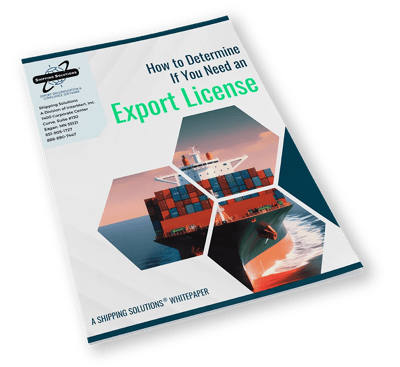 Export License
Export License
A government-issued permit that authorizes a shipper to export a certain good or to export to a certain country or party. Download the free whitepaper: How to Determine if You Need an Export License.
Export Management Company
Exporting companies without their own export department sometimes outsource their export operations to an export management company (EMC).
Export Quotas
Specific restrictions or ceiling imposed by an exporting coun try on the value of volume of certain exports typically designed to protect domestic producers and consumers from temporary shortages of goods or to bolster their price in world markets.
Export Subsidies
Government penalities or other financially quantifiable benefits provided to domestic producers or exporters contingent on the export of their goods and services.
Export Trading Company
A company that acts as an independent distributor and links domestic producters with foreign buyers. They determine what U.S. products are desired in a given market and then work with U.S. producers to satisfy the demand.
EXW (ExWorks)
EXW is an Incoterm for any mode of transport. The seller fulfills its obligations by having the goods available for the buyer to pick up at its premises or another named place (i.e. factory, warehouse, etc.) on a date agreed upon by both parties or within an agreed-upon timeframe. The seller needs to provide the buyer the information they need to take delivery of the goods at that time. With Ex Works, the buyer bears all risk and costs starting when the goods are made available to the buyer at the seller’s location or other named place until the products are delivered to its location. Seller has no obligation to load the goods or clear them for export.
FAK
Abbreviation for “freight all kinds.” Typically refers to a full container loaded with mixed cargo.
False Billing
Misrepresenting freight information on shipping documents.
FAS (Free Alongside Ship)
FAS is an Incoterm for sea and inland waterway transport. Seller clears the goods for export and delivers them when they are placed alongside the vessel at the named port of shipment. Buyer assumes all risks/costs for goods from this point forward.
FCA (Free Carrier)
FCA is an Incoterm for any mode of transport. The seller is responsible for either making the goods available at its own premises or at a named place. In either case, the seller is responsible for loading the goods on the buyer's transport and is responsible for delivery to the port and export clearance including security requirements. Risk transfers once the goods are loaded on the buyer’s transport.
Federal Maritime Commission (FMC)
The agency within the U.S. federal government tasked with enforcing laws related to transport of goods by sea.
Federal Register
The Federal Register, sometimes abbreviated as Fed. Reg., FedReg, or FR, is the official journal of the U.S. government where new rules and regulations are published.
FEU (Forty-Foot Equivalent Unit)
A standard 40-foot shipping container, measuring approximately 40 feet long, 8 feet wide and 8.1 feet high. One standard FEU can hold 22 to 23 pallets. The container can carry approximately 58,930 pounds, depending on the shipping line's limitations. One FEU has the capacity of two TEUs.
FOB (Free on Board)
FOB is an Incoterm for sea and inland waterway transport. Seller clears the goods for export and delivers them when they are on board the vessel at the named port of shipment. Buyer assumes all risks and costs for goods from this moment forward.
Force Majeure
A common clause included in contracts that exempts parties for not fulfilling their obligations due to events beyond their control, such as natural disasters or war.
Fore and Aft
The direction on a ship parallel to the center line.
Foreign Agricultural Service (FAS)
A U.S. Department of Agriculture bureau with programs related to market development, international trade agreements and negotiations, and the collection of statistics and market information.
Foreign Corrupt Practices Act (FCPA)
An act making it unlawful for persons or companies subject to U.S. jurisdiction to offer, pay or promise to pay money or anything of value to any foreign official for the purpose of obtaining or retaining business. See also, The Foreign Corrupt Practices Act (FCPA).
Foreign Trade Zone
Areas where commodities can be manufactured, modified or stored under specific customs regulations and generally not subject to customs duties. May be abbreviated FTZ and sometimes called a free trade zone or free port. See also: Foreign Trade Zones: Advantages for Importers and Exporters.
FPPI
Foreign principal party of interest is the party to whom final delivery of the goods will be made, typically the foreign buyer.
Free Time
The amount of time that a carrier’s equipment may be used without incurring additional charges.
Freight
Any product(s) being transported.
Freight Broker
A person who arranges transportation on behalf of a shipper. Typically a freight broker will connect small shippers to carriers who can move their goods.
Freight Forwarder
A company that arranges the transportation of goods on behalf of a shipper. A freight forwarder may have its own in-house carriers or may contract with external carriers. Freight forwarders often specialize in consolidating LTL freight from multiple shippers.
FTA
Free trade agreements are made between countries in an effort to reduce barriers to trade between the participating countries. They usually involve lowering of duty rates for shipments between participating countries, but may also include provisions for intellectual property rights, environmental protection, dispute resolution and more.
FTR
The Foreign Trade Regulations (FTR) are a set of regulations placed on international trade in the U.S. They are established and updated by the U.S. Census Bureau. It is in the FTR that the requirement to file the Electronic Export Information (EEI) through the Automated Export System (AES) can be found. See also: Why Is the Census Bureau Monitoring Your Exports?
Full Truckload (FTL)
A full truckload carrier is a carrier that contracts the entirety of a truck’s carrying capacity to a single customer. Often referred to as a truckload carrier.
GBS—Shipments to Country Group B Countries
Export license exception GBS authorizes exports and re-exports to Country Group B (see Supplement No. 1 to part 740) of those commodities where the Commerce Country Chart indicates a license requirement to the ultimate destination solely for reason National Security (NS) and identified by “GBS—Yes” on the CCL. See Part 743.1 of the EAR for reporting requirements for exports of certain commodities under License Exception GBS. Learn more: What You Need to Know about Export License Exceptions.
General Agreement on Tariffs and Trade (GATT)
A legal agreement between many countries which promoted international trade by eliminating trade barriers such as tariffs and quotas. It was succeeded by the World Trade Organization (WTO) in 1995, with the original GATT text remaining part of the WTO framework.
General Order
When U.S. Customs and Border Protection (CBP) orders shipments without entries to be kept in their custody.
GFT—Gift Parcels and Humanitarian Donations
The provisions of export license exception GFT are explained in Part 740.12 and authorize exports and reexports of gift parcels by an individual (donor) addressed to an individual, or a religious, charitable or educational organization (donee) located in any destination for the use of the donee or the donee's immediate family (and not for resale).
The gift parcel must be provided free of charge to the donee. However, payment by the donee of any handling charges or of any fees levied by the importing country (e.g., import duties, taxes, etc.) is not considered to be a cost to the donee for purposes of this definition of gift parcel. Learn more: What You Need to Know about Export License Exceptions.
GOV—Governments, International Organizations, International Inspections Under the Chemical Weapons Convention, and the International Space Station
Export license exception GOV authorizes exports and re-exports to U.S. government agencies as well as exports and re-exports related to the United States’ participation in international treaties and agreements. It is explained in Part 740.11, which is divided into five sections:
- International Safeguards
- United States Government
- Cooperating Governments and the North Atlantic Treaty Organization
- International Inspections Under the Chemical Weapons Convention (CWC)
- International Space Station (ISS)
Learn more: What You Need to Know about Export License Exceptions.
Gross Domestic Product (GDP)
The total value of all goods and services produced by a country.
Gross Vehicle Weight (GVW)
The total weight of a vehicle including the weight of the vehicle itself and any attached containers.
Harbor
A place where ships stop to resupply and load or unload cargo.
Harbor Master
An official responsible for overseeing harbor operations.
Hatch
The opening on the deck of a ship that gives access to the cargo hold.
 Hazardous Materials (HazMat)
Hazardous Materials (HazMat)
May be used interchangeably with the term “dangerous goods,” hazardous materials are goods that may pose a threat to safety because they are poisonous, toxic, corrosive, explosive, flammable, etc. More precisely, hazardous materials are defined by the U.S. Department of Transportation in accordance with the Federal Hazardous Material Law. It is more common to see the term “hazardous materials” used when shipping domestically within the U.S., whereas the term “dangerous goods” is used more often when shipping internationally. Shipping hazardous materials may require special documentation or packaging to ensure safety.
High Bandwidth Memory (HBM)
Effective on December 2, 2024, BIS placed new controls on high-bandwidth memory units under 3A090.c. At the same time, it created this new license exception to allow for the export of certain less advanced high-bandwidth memory units as long as the conditions specified in Party 740.25 of the EAR are met. Learn more: What You Need to Know about Export License Exceptions.
HMF
Harbor maintenance fee. See also: A Case of HaruMpF and MumPF.
House Bill of Lading
A house bill of lading (HBL) is a document issued by a freight forwarder or a non-vessel operating company (NVOCC) to a shipper to acknowledge receipt of their items for shipment. In other words, it's a receipt for the goods. This is different from the Master Bill of Lading, which is issued by the carrier and is a contract of carriage for the goods.
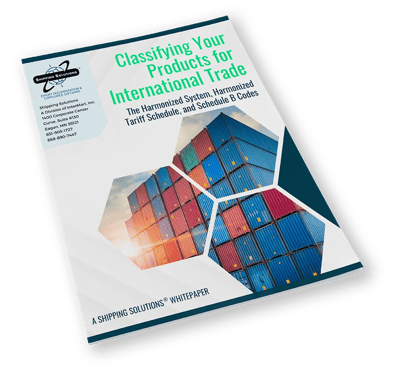 HS
HS
The Harmonized System is an internationally accepted system used to classify products. The first six digits of an HS code are universal across all countries, but each country will add additional digits to further specify products. HS codes play a role in determining import and export controls as well as duty rates. The code for a particular product is often called its tariff classification, as is the process for finding the right code.
HTSUS
The Harmonized Tariff Schedule of the United States is a classification system used for importing into the United States. It is based on the internationally recognized Harmonized System (HS).
IEC: Implemented Export Controls
Effective on September 6, 2024, BIS implemented export controls on several semiconductor, quantum and additive manufacturing items for national security and foreign policy reasons. This rule adds new Export Control Classification Numbers (ECCNs) to the Commerce Control List, revises existing ECCNs and adds a new license exception—Implemented Export Controls (IEC)—to authorize exports and reexports to and by countries that have implemented equivalent technical controls for these newly added items. This IEC chart lists eligible items and destinations. Learn more: What You Need to Know about Export License Exceptions.
IMDG
International Maritime Dangerous Goods code; the regulations established by the International Maritime Organization (IMO) for the international transport of dangerous goods.
Import
Shipment of goods into a country. Opposite of export.
Import Declaration
Information submitted by an importer or their agent to their country’s customs authority before or upon importation of goods, such as the contact details of the importer, how the goods are being transported and the tariff classifications and values of the items on the shipment.
Import License
A government-issued permit authorizing a party to import a good into the country.
In Bond
An import or export shipment that has not yet cleared customs is referred to as in bond.
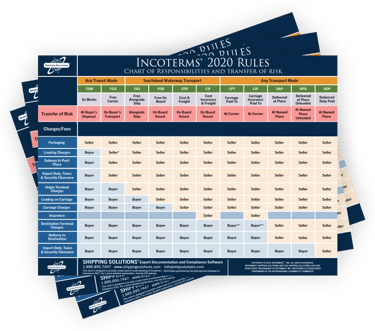 Incoterms
Incoterms
Incoterms are universal trade terms published by the International Chamber of Commerce (ICC.) They consist of three-letter codes that are intended to clearly communicate the tasks, costs and risks associated with the transportation and delivery of goods in an international transaction. They describe how responsibility is allocated between the seller and the buyer for different parts of the transaction. Download the free Incoterms 2020 Chart of Responsibilities and Transfer of Risk.
Indirect Exporting
A sale by an exporter to the buyer through a domestically located intermediary, such as an export management company or an export trading company.
Inspection Certificate
A document required by some purchasers and countries to attest to the specifications of the goods shipped. The inspection is usually performed by a third party.
Insurance Certificate
A document prepared by the exporter or freight forwarder as evidence that insurance against loss or damage has been obtained for the goods.
Intellectual Property (IP)
The collective term used to refer to new ideas, inventions, designs, writings, films and so on that are protected by copyright, patent or trademark. See also, 10 Terms Exporters Should Know about Intellectual Property.
Interchange Point
A location where freight is transferred from one carrier to another.
Intermediate Bulk Container
Also commonly known as a tote, IBC tote or IBC tank, IBC totes can be used to ship liquids, pastes, semi-solids and solids. They are used in a variety of industries and applications, including agriculture, construction, industrial lubricants, collecting rainwater and many others. The two most common totes are the composite 275-gallon and 330-gallon tanks made of a high-density polyethylene (HDPE) inner liner, surrounded by a galvanized steel cage. They take up a similar footprint to a standard pallet of 48” L x 40” W x 46” H.
Intermodal
Intermodal transportation is the movement of goods via more than one type of transportation (e.g. air, rail, sea, truck, etc.). An intermodal container is one that can be used in different modes of transport without having to unload the goods and reload them at each point at which the mode of transport changes. In the context of international trade, intermodal container is usually synonymous with container.
International Chamber of Commerce (ICC)
The ICC plays a role in rule setting, dispute resolution, and policy advocacy in international trade, supporting the commerce goals of the United Nations and the World Trade Organization.
International Trade Administration (ITA)
A U.S. Department of Commerce bureau responsible for export promotion programs.
Inward Foreign Manifest (IFM)
A document listing all cargo entering a country. Required by all world ports and is the primary source from which import duties are assigned.
ISPM 15
International Standards for Phytosanitary Measures No. 15 (ISPM 15) is an international environmental standard for treating wood packaging materials (WPM) in order to curb the spread of plant pests. Under the ISPM 15 rules, all wood packaging materials such as pallets, crates and boxes must be debarked, then heat treated or fumigated to eliminate insects or diseases which could be harmful to ecosystems. The United States Department of Agriculture (USDA) adopted this standard in September 2005.
ITAR
The International Traffic in Arms Regulations regulate the export of space- or defense-related products and are enforced by the U.S. Department of State. See also: Understanding ITAR: The International Traffic in Arms Regulations.
JIT
Abbreviation for "just in time." A method of inventory control which minimizes warehousing and in which the container itself acts as a movable warehouse and arriving on schedule is crucial.
J-List
Found in 19 CFR 134.33, the J-List is a list of items exempt from country of origin marking requirements when importing into the United States. Items on the J-list are usually exempt because they are either incapable of being marked (e.g. liquids) or marking them is impractical (e.g. fine art).
Laden
Loaded aboard a vessel.
Landed Cost
The total cost of an international shipment, found by adding the price paid by the buyer to the seller, shipping costs, shipment insurance and all applicable import duties and fees.
Less-than-Truckload, Less-than-Load (LTL)
A medium shipment, typically between 150 pounds and 20,000 pounds. An LTL carrier mixes freight from several customers in a single truckload. May also be called less-than-container (LCL).
Letter of Credit
Also called a documentary collection and often abbreviated as LC or L/C, a letter of credit is a written commitment by a bank issued after a request by an importer that payment will be made to an exporter provided that the terms of the letter of credit have been met as evidenced by the presentation of certain documents. See also: What's a Letter of Credit? (Infographic).
License Exception
Certain criteria may be met that allow an exporter to export a product without an export license in cases where an export license would normally be required. These criteria are called license exceptions. See also: What You Need to Know about Export License Exceptions.
Licensing
An arrangement in which a company sells the rights to use its products or services but retains some control.
Liquidated Damages
The penalty a seller must pay the buyer if a project does not meet the standards or deadline outlined in the sales contract.
Liquidation
In the context of importing, liquidation is the process in which the customs authority finalizes its review of an entry and calculates the exact duties owed.
List
The amount that a vessel tilts from the vertical, measured in degrees.
Logistics
The management of the flow of products as they are transported from the point of origin to their final destination. A logistics company is a general term for a company that provides logistics services, which may include freight forwarding, customs brokerage and/or consulting services.
Longshoreman
A port employee tasked with loading and unloading ships.
LPP—Low Processing Performance
This low volume export license exception allows limited amounts of compute to flow globally, except to arms-embargoed countries. Learn more: What You Need to Know about Export License Exceptions.
LVS—Shipments of Limited Value
Each ECCN that lists the LVS export license exception also lists a corresponding value limit unique to that ECCN under its entry in the Commerce Control List. The LVS criteria are simple: if the value of the goods on a single order listed under a single ECCN does not exceed the LVS limit listed under that ECCN’s entry in the CCL, the export is eligible for this License Exception. Learn more: What You Need to Know about Export License Exceptions.
Malpractice
In the context of shipping, malpractice refers to situations in which a carrier illegally gives preference to a customer in order to attract their business.
Maritime
Relating to transport by sea.
Marking
Letters, numbers or other symbols placed on packaging used for identification purposes.
Master Bill of Lading
A bill of lading issued by a carrier to a freight forwarder acknowledging receipt of container for shipment. This is different from a house bill of lading which is issued by a freight forwarder to a shipper, acknowledging receipt of their items for shipment.
MED—Medical Devices
Export license exception MED permits the export, re-export or transfer of "medical devices" designated as EAR99 to or within Russia, Belarus, Crimea, and certain covered regions in Ukraine. This exception includes parts, components, accessories and attachments for use with these devices, provided these items are also EAR99-designated and meet additional specific conditions. The MED exception ensures that critical medical equipment can reach areas where it may be urgently needed. See 740.23 for more details. Learn more: What You Need to Know about Export License Exceptions.
Most Favored Nation (MFN)
A status accorded by one national government to another in the context of international business. A country with MFN status may not be treated less favorably in international transactions than any other country with MFN status.
MPF
Merchandise processing fee. See also: A Case of HaruMpF and MumPF.
Multimodal
See intermodal.
NAC/ACA—Notified Advanced Computing and Advanced Computing Authorized
Export license exceptions NAC and ACA facilitate exports, re-exports and in-country transfers of certain advanced computing items classified under specific ECCNs in the CCL. These ECCNs typically cover high-performance computing equipment, such as microprocessors and microcontrollers, computer systems and encryption equipment.
License Exception NAC authorizes the export and re-export of eligible items to Macau and destinations in Country Group D:5, as well as to entities headquartered in or with a parent in these destinations, subject to specific criteria. License Exception ACA permits exports, reexports, and in-country transfers of these items to destinations within Country Groups D:1 and D:4, with exclusions for Macau and D:5 destinations. To use NAC or ACA, exporters must generally secure a written purchase order. Learn more: What You Need to Know about Export License Exceptions.
NAFTA
The North American Free Trade Agreement was established in 1994 to harmonize trade between the United States, Canada and Mexico. Companies located in these countries may be eligible for reduced duty rates when importing if their goods qualify under the terms of NAFTA. NAFTA was replaced on July 1, 2020, by the United States-Mexico-Canada Agreement (USMCA).
NCBFAA
The National Customs Brokers and Forwarders Association of America is an organization representing the interests of customs brokers and freight forwarders in the U.S. They publish guidelines on best practices, including specific guidelines on how to create a shipper’s letter of instruction (SLI) when authorizing freight forwarders to file through the Automated Export System (AES) on behalf of the exporter.
NEC, NES
Not elsewhere classified, not elsewhere specified.
Negotiable/Non-Negotiable
A negotiable instrument is a document that can be transferred from its original holder to a third party. A non-negotiable document cannot be transferred to another party. An inland or ocean bill of lading may be either negotiable or non-negotiable; a bill of lading consigned “to order” or “to order of shipper” is negotiable once it is endorsed on the back by the shipper or their representative. Air waybills are always non-negotiable. See also: What Is a Bill of Lading: 3 Things You Need to Know.
Net Weight
The weight of goods not including the weight of their packaging.
Non-Dumping Certificate
Required by some countries to ensure protection against dumping of certain products.
NVOCC
A non-vessel operating common carrier behaves like a carrier except it doesn’t provide the actual transportation service itself. Instead, a NVOCC buys space from carriers and sells this space to shippers.
.webp?width=400&height=518&name=Ocean%20Bill%20of%20Lading%20(1).webp) Ocean Bill of Lading
Ocean Bill of Lading
The ocean bill of lading serves as both a contract for carriage and a document of title for the cargo. The bill of lading identifies the parties on both ends of the shipment, as well as a description of the goods and routing instructions.
Office of the U.S. Trade Representative
A U.S. government agency responsible for negotiating trade agreements.
On Board
A notation on a bill of lading indicating that cargo has been loaded on a ship.
On Deck
A notation on a bill of lading indicating that cargo has been stowed on the open deck of a ship.
Open Account
A transaction in which goods are shipped to a foreign buyer without guarantee of payment.
Operating Ratio
A measure of operating efficiency based on a comparison between a carrier’s operating expenses and its net sales.
Origin
Can mean 1) location where a shipment starts its journey, or 2) country where goods were originally manufactured.
Overage
When the number of units received is greater than the quantity stated on the export documents. Opposite of shortage.
Packing List
A standard document that accompanies a shipment. Also called a packing slip, this document lists the products on a shipment along with packaging information but does not include prices. See also: The Importance of an Export Packing List for Your International Shipments.
Pallet
A platform on which packages may be loaded. Facilitates easier handling by a lift truck.
Panama-United States Trade Promotion Agreement
The free trade agreement between the United States and Panama that came into effect in October 2012. It is designed to eliminate obstacles to trade between the two countries and is notable for being the United States’ only bilateral free trade agreement with a Central American country.
Parcel/Package/Small Parcel/Small Package
A small shipment, typically less than 150 pounds.
Patent
A right that entitles the patent holder, within the country that granted or recognizes the patent, to prevent all others, for a set period of time, from using, making or selling the subject matter of the patent. See also, 10 Terms Exporters Should Know about Intellectual Property.
Payee
The party paid in a transaction; the seller.
Payer
The party paying money in a transaction; the buyer.
Payment Terms
Terms that describe how money will be paid in a transaction. Typically, the shipper is responsible for payment for prepaid shipments, while the consignee is responsible for payment for collect shipments, unless a third party is indicated as the payor on the shipping documents.
Phytosanitary Inspection Certificate
A document issued by the U.S. Department of Agriculture certifying that a shipment has been inspected and is free from harmful pests and plant diseases. Used to meet import requirements of other countries.
Pier
A structure perpendicular to the shoreline to which a ship is secured in order to load or unload cargo.
Place of Delivery
Location where cargo leaves the custody of a carrier.
Place of Receipt
Location where cargo enters the custody of a carrier.
POD
Abbreviation for 1) port of discharge, 2) port of destination, or 3) proof of delivery, a document provided by the carrier required to receive payment.
Point of Origin
The location where a shipment is transferred from a shipper to a carrier.
POL
Abbreviation for 1) port of loading or 2) petroleum, oil and lubricants.
Political Risk
The likelihood that political forces will cause drastic changes in a country’s business environment that adversely affect the profit and other goals of a business enterprise. This may include political violence, expropriation, confiscation and domestication (sometimes called nationalization). See also: Why Managing Political Risk Is Critical for Exporters
Port
May refer to 1) a harbor with piers or docks, 2) the left side of a ship (when facing forward, opposite of starboard), or 3) an opening in the side of a ship used for handling freight.
Port of Call
Port where a ship discharges or receives traffic.
Port of Entry
Port where cargo is unloaded and enters a country.
Port of Exit
Port where cargo is loaded and leaves a country.
PPI
Principal party of interest. See FPPI and USPPI.
Prepaid
Freight charges paid by a shipper prior to release of bills of lading by the carrier.
Product Classification
In the context of international trade, there are many classification systems that allocate specific numeric or alphanumeric codes to particular categories of products, including the Harmonized System (HS) and derivatives of the HS such as Schedule B and the U.S. Harmonized Tariff Schedule (HTS), as well as Export Control Classification Numbers (ECCNs) and United States Munitions List (USML) categories. Knowing the correct classifications of the products you export is important for customs clearance and determining if you need an export license. Also called commodity classification. (Download our free whitepaper Classifying Your Products for International Trade).
.webp?width=400&height=518&name=Proforma%20Invoice%20Download%20Now%20(1).webp) Proforma Invoice
Proforma Invoice
A document that acts as a formal quote, produced by the seller and given to the potential buyer before a transaction is finalized. See also: How Does the Proforma Invoice Fit in the Sales Process?
Quarantine
A restriction placed on an operation in order to protect public health and safety.
Quota
The quantity of goods that may be imported without restrictions over a set period of time.
Quotation
Usually called a quote, an offer to sell goods at a stated price under stated conditions.
Rate Basis
The formula of specific factors that play a role in determining freight rates.
Reasons for Control
Specific reasons outlined in the U.S. Export Administration Regulations that denote why an exporter would need to apply for an export license. Examples include National Security (NS) and Regional Stability (RS). These exist both at the country level and at the Export Control Classification Number (ECCN) level. In order for a reason for control to apply to a shipment, it must be listed at both the country level and ECCN level. See our article: Export Administration Regulations: Understanding Reasons for Control.
RFP, RFQ
Request for proposal, request for quotation.
Reasonableness
Under ICC and common law, the requirement that a freight rate not be higher than what is necessary to reimburse the carrier and allow a fair profit.
Regional Value Content (RVC)
A technique used to determine whether a product meets a rule of origin. See also, Trade Agreements—FTAs, TPAs, Unilateral, Bilateral, Multilateral: How Do They Differ?
Relay
The transfer of containers from one ship to another when both ships are controlled by the same carrier.
Remittance
Funds sent by one person to another as payment.
Revenue
Payment received by a carrier for transporting goods.
RFF—Restricted Fabrication Facility
Effective on December 2, 2024, BIS implemented export controls designed to impair China's production of advanced semiconductors and other items that can be used in advanced weapon systems, AI and advanced computing in support of China's military-civilian fusion program. At the same time, this rule creates export license exception RFF to allow certain facilities of entities on the Entity List to continue to receive certain legacy semiconductor manufacturing equipment and other items to produce non-advanced-node integrated circuits subject to certain requirements. Only Wuhan Xinxin/XMC is currently eligible for this new license exception. Learn more: What You Need to Know about Export License Exceptions.
Roll-on/Roll-off
Also called RORO or ro-ro for short, these are vessels designed to carry wheeled cargo, such as vehicles and trailers. This is in contrast to lift-on/lift off (LoLo) vessels which use a crane to load and unload cargo.
RPL—Servicing and Replacement of Parts and Equipment
Export license exception RPL authorizes exports and re-exports associated with one-for-one replacement of parts, components, accessories and attachments. RPL also authorizes exports and re-exports of certain items currently subject to the EAR to or for, or to replace, a defense article described in an export or re-export authorization issued under the authority of the Arms Export Control Act. It does not, however, authorize the export or reexport of defense articles subject to the ITAR, i.e., described on the United States Munitions List (22 CFR 121.1). Learn more: What You Need to Know about Export License Exceptions.
Sanction
An embargo enforced by a government against another country.
SBA
The Small Business Administration is an executive agency of the U.S. government that exists to encourage and facilitate the growth and development of small businesses and entrepreneurs in America.
SBDC
America’s Small Business Development Centers are a network of hundreds of offices across the U.S. that provide support services to local small businesses. SBDC’s are administered by the SBA.
SCAC
Standard Carrier Alpha Codes are developed by the National Motor Freight Traffic Association and used to identify inland carriers in the U.S.
Schedule B
Schedule B codes are used specifically for exporting out of the U.S. They are based on HS codes and used by the U.S. Census Bureau to calculate trade statistics and by U.S. Customs and Border Protection to ensure that exporters are following U.S. export regulations.
SCP—Support for the Cuban People
Part 740.21 of the EAR explains the provisions of license exception SCP that authorizes certain exports and re-exports to Cuba that are intended to support the Cuban people by improving their living conditions and supporting independent economic activity; strengthening civil society in Cuba; and improving the free flow of information to, from and among the Cuban people. Learn more: What You Need to Know about Export License Exceptions.
Section 232 Tariffs
Under Section 232 of the Trade Expansion Act of 1962, the President of the United States is granted the power to adjust import tariffs if excessive foreign imports pose a threat to national security. In recent practice, these tariffs are primarily placed on imports of aluminum and steel. This was implemented as a result of the United States International Trade Commission (USITC) reports that steel imports can be harmful to the United States steel industry, particularly in the case where nations that export steel to the United States unfairly subsidize their products or sell them at an artificially low price.
Section 301 Tariffs
Under Section 301 of the Trade Act of 1974, the Office of the United States Trade Representative (USTR) files a Special 301 Report annually which identifies “Priority Foreign Countries,” countries that have inadequate intellectual property laws or have violated trade agreements. These countries may be subject to sanctions or tariffs at the behest of the President of the United States. A recent example is the tariffs imposed on imports from China by the Trump Administration.
Ship’s Tackle
Equipment such as rigging or cranes used on a ship for loading or unloading cargo.
Shipper
In the context of international trade, shipper is used to identify the company selling the goods to a foreign market. The shipper may also be called the exporter or consignor in this case.
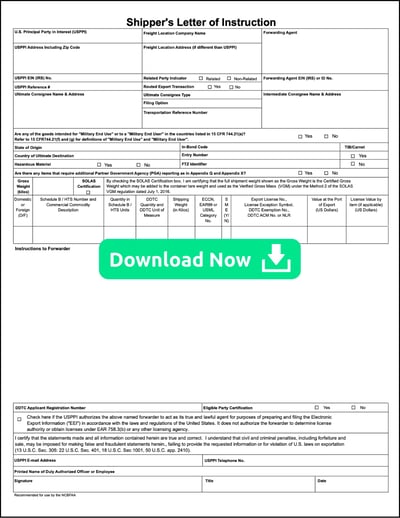 Shipper’s Letter of Instruction (SLI)
Shipper’s Letter of Instruction (SLI)
A document provided by an exporting company to their freight forwarder outlining instructions for the freight forwarder. If the freight forwarder is filing through the Automated Export System (AES) on behalf of the exporter, the SLI includes the information they need to complete the filing. See also: 5 Reasons You Need a Shipper's Letter of Instruction for Your Exports.
Shipping Documents
Paperwork that accompanies a shipment as it makes its way to the final destination, such as packing lists or bills of lading.
Shipping Solutions
Export documentation and compliance software that makes creating accurate export documents fast and easy.
Shortage
When the number of units received is less than the quantity stated on the shipping documents. Opposite of overage.
Sight Draft
A document used when the exporter wishes to retain title to the shipment until it reaches its destination and payment is made. Before the shipment can be released to the buyer, the original "to order" ocean bill of lading must be properly endorsed by the buyer and surrendered to the carrier. See also, Understanding Bank Drafts: Sight Drafts versus Time Drafts.
Skids
Devices placed beneath boxes or packages in order to raise them off the floor to permit access by a forklift.
Small Business Development Center (SBDC)
A national network of counselors for small enterprises that often offer services that can help first-time exporters.
SNAP-R
Simplified Network Application Process—Redesign (SNAP-R) is a system maintained by the Bureau of Industry and Security (BIS) in the U.S. Commerce Department that enables U.S. companies to submit export license applications, commodity classification requests, reexport license applications and license exception AGR notifications via the Internet.
SOLAS
Safety of Life at Sea Convention is enforced by the International Maritime Organization (IMO). Under SOLAS, exporters are required to provide a verified weight of the goods before they are loaded onto a ship for transport. See also: New Weight Verification Requirements Coming in July 2016.
Sourcing
The procurement of goods or services from a particular entity or country, as well as the business process of vetting potential suppliers to determine which will give the greatest strategic advantage. See our article: How Sourcing Impacts the Supply Chain.
Spotting
Placing a container in a position from which it can be loaded or unloaded.
STA—Strategic Trade Authorization
Export license exception STA authorizes the export, re-export and transfer (in-country) of certain items on the CCL to destinations posing a low risk of unauthorized or impermissible uses. If items have multiple reasons for control, this exception can be used for exports to a list of 36 countries; if it has a National Security (NS) reason for control, it can be used for a smaller list of eight countries.
To prevent re-exports to unauthorized destinations, a prior statement from the consignee is required along with specific notification requirements. If an export is eligible for STA and one or more other license exceptions, the exporter may claim one of the other ones, which exempts them from the prior statement and notification requirements specific to license exception STA. Learn more: What You Need to Know about Export License Exceptions.
Starboard
The right side of a ship (when facing forward). Opposite of port.
Stern
The backside of a ship. Opposite of bow.
STC
Said to contain.
Stevedore
Individual or company that employs longshoremen and contracts for the loading and unloading of ships.
Stripping
Removing cargo from a container.
Stuffing
Putting cargo into a container.
STW
Said to weigh.
Supply Chain
A system of interconnected organizations and activities involved in the movement of goods from a supplier to a customer.
Surcharge
An extra or additional charge.
Surtax
An extra or additional tax.
Tail
Backside of a container or trailer. Opposite of front or nose.
Tare Weight
The weight of a container while empty.
Tariff
A tax imposed on a product when it is imported into a country. Some foreign countries apply tariffs to exports.
Terms of Sale
Terms that define the obligations, risks and costs of the buyer and seller involving the delivery of goods that comprise an export transaction. These terms are commonly known as Incoterms. See also, An Introduction to Incoterms.
Terminal
Also called a container terminal, a location where containers are picked up, dropped off, maintained and kept.
Terminal Charge
A charge for a service carried out in a carrier’s terminal area.
TEU (Twenty-Foot Equivalent Unit)
A standard 20-foot shipping container, measuring approximately 20 feet long, 8 feet wide and 8 feet high. One standard TEU can hold 9 to 11 pallets. The container can carry approximately 56,000 pounds, depending on the shipping line's limitations. Two TEUs have the capacity of a single FEU.
Third Party Logistics (3PL)
A company that provides logistics services to other companies, such as warehousing and transportation.
Time Draft
A document used when the exporter extends credit to the buyer. The draft states that payment is due by a specific time after the buyer accepts the time draft and receives the goods. By signing and writing "accepted" on the draft, the buyer is formally obligated to pay within the stated time. See also, Understanding Bank Drafts: Sight Drafts versus Time Drafts.
TL
Trailer load.
TMP—Temporary Imports, Exports, Re-exports, and Transfers In-Country
Export license exception TMP authorizes various temporary exports and re-exports; exports and re-exports of items temporarily in the United States; and exports and re-exports of beta test software.
Part 740.9 details categories of items that are potentially covered under TMP. This includes tools of the trade, which refers to standard tools and equipment as well as software necessary for a business to carry out its day-to-day functions. Software used as a tool of trade must be protected from unauthorized access. Learn more: What You Need to Know about Export License Exceptions.
Trademark
A word, symbol, name, slogan or combination thereof that identifies and distinguishes the source of sponsorship of goods and may serve as an index of quality of a particular product. See also, 5 Strategies for Exporters to Protect Their Trademarks Globally.
Trade Statistics
Data that indicate total exports or imports by country and by product. They allow you to compare the size of the market for a product in various countries. By looking at statistics over several years, you can determine which markets are growing and which markets are shrinking.
Trading House
A company that specializes in exporting and importing goods produced or provided by other companies.
Trailer
A container attached to the back end of a truck.
Transshipment
The transfer of cargo from one carrier to another or from one vehicle to another at an intermediate point during the goods’ journey to the final destination.
Truck Tonnage
The weight (in tons) of a shipment transported by truck.
TSR—Technology and Software Under Restriction
Export license exception TSR is available for exports and re-exports destined for countries in Country Group B for ECCNs with National Security (NS) as their only Reason for Control and with “TSR—Yes” listed under their entry on the CCL.
To be eligible for this license exception, the exporter must first obtain written assurance from the consignee that they will abide by certain conditions that are detailed in Part 740.6. Learn more: What You Need to Know about Export License Exceptions.
TSU—Technology and Software Unrestricted
Export license exception TSU authorizes exports and re-exports of operation technology and software; sales technology and software; software updates (bug fixes); mass market software subject to the General Software Note (see Supplement No. 2 to Part 774); and release of technology and source code in the United States by U.S. universities to their bona fide and full-time regular employees. Learn more: What You Need to Know about Export License Exceptions.
Turnaround
A term used in marine transportation referring to the time it takes between arrival of a ship and its departure.
Ullage
The space not filled with liquid in a drum or tank.
Unclaimed Freight
Freight that has not been called for or picked up by the owner or ultimate consignee.
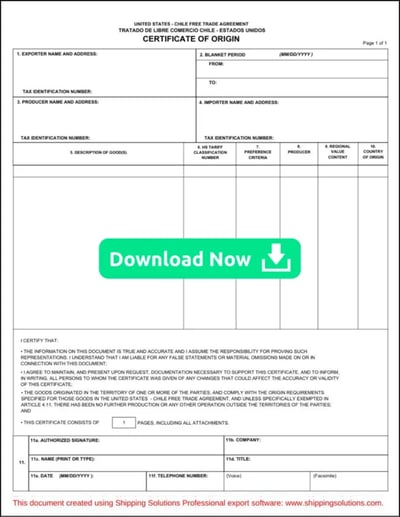 United States-Chile Free Trade Agreement
United States-Chile Free Trade Agreement
A free trade agreement between the United States and Chile that went into effect Jan. 1, 2004. On that date, the vast majority of tariffs between the two countries were eliminated, and it was agreed that Chile and the United States would establish duty-free trade across all product categories within 12 years (by 2016).
United States-Colombia Trade Promotion Agreement (CTPA)
A free trade agreement between the United States and Colombia that went into effect May 15, 2012. The United States is Colombia’s leading trade partner. Immediately upon implementation, the agreement eliminated 80% of duties on U.S. consumer and industrial exports to Colombia. It also granted duty-free status to a variety of agricultural exports from both countries, including beef, cotton, wheat and certain fruits and vegetables.
United States-Israel Free Trade Agreement
A free trade agreement between the United States and Israel that went into effect in 1985 and is notable for being the United States’ first free trade agreement with another country. The agreement reduces or eliminates duties on imports into the United States from Israel and contributed to the U.S. becoming Israel’s top trading partner. It is the only U.S. free trade agreement to not include provisions on intellectual property rights.
United States-Korea Free Trade Agreement
A free trade agreement between the United States and South Korea, officially named the Free Trade Agreement Between the United States of America and the Republic of Korea (KORUS). It went into effect in March 2012 and is notable for being South Korea’s largest trade agreement second only to its trade deal with the European Union.
United States-Peru Trade Promotion Agreement
Called the PTPA for short, this is a free trade agreement between the United States and Peru that was implemented in February 2009. More than two-thirds of U.S. farm exports to Peru became duty free immediately upon implementation. In addition to commerce, the agreement includes provisions related to intellectual property rights, labor and environmental policies.
Unit Load
Packages loaded onto a pallet, in a crate or in some other way that allows for the goods to be handled as a single unit. This process is called unitization.
UN Number
An internationally recognized four-digit code used to identify dangerous goods. See also: Creating the IATA Dangerous Goods Form: The Shipper's Declaration for Dangerous Goods.
U.S. Agency for International Development (USAID)
U.S. government agency that procures goods and services from U.S. companies for use in developing countries.
U.S. Commercial Service
The trade promotion arm of the U.S. Department of Commerce's International Trade Administration.
U.S. Department of Agriculture (USDA)
A branch of government responsible for developing and executing federal government policy on farming, agriculture, forestry and food.
U.S. Department of Commerce (DOC)
A branch of government responsible for promoting domestic economic growth.
U.S. Small Business Administration (SBA)
The U.S. government agency that manages programs for U.S. exporters, including finance programs.
U.S. Trade and Development Agency (USTDA)
A U.S. government agency that provides grants for feasibility studies in developing countries.
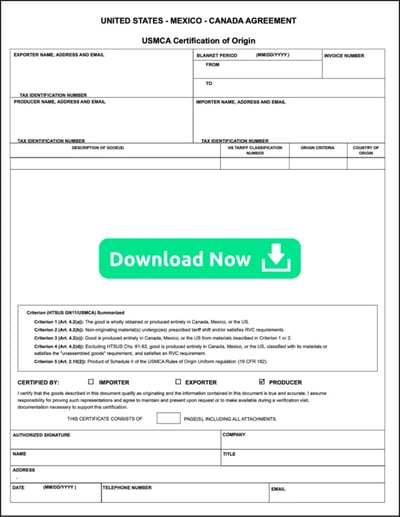 USMCA
USMCA
On July 1, 2020, the United States-Mexico-Canada Agreement replaced NAFTA as the free trade agreement between the three countries. In Canada, it is officially known as the Canada–United States–Mexico Agreement (CUSMA). In Mexico, it is called the Tratado entre México, Estados Unidos y Canadá (T-MEC). Under USMCA, qualifying products are exempt from tariffs and quotas when traded between those three countries. To claim this preferential duty rate, you must determine if your goods qualify under the USMCA Rules of Origin. Download a free copy of the USMCA Certification of Origin form.
USML
The United States Munitions List is a list of space- and defense-related products that are controlled by the U.S. Department of State under the International Traffic in Arms Regulations (ITAR). See also: USML vs. ECCN: What's the Difference.
USPPI
The United States Principal Party in Interest is the party that receives the primary benefit from an export transaction, monetary or otherwise. Usually the seller of the goods. See also: How to Determine the USPPI.
Value-Added Tax (VAT)
A consumption tax assessed by most countries that increases at every point in the supply chain where value is added to it. See our article: Exporters May Be Eligible for Import Tax Refunds.
Vessel
A seafaring vehicle; a boat or ship.
Vessel Manifest
A document listing details regarding the crew and cargo onboard a vessel.
Vessel Traffic Service (VTS)
A traffic monitoring system used by harbor or port authorities used to monitor ships, similar to air traffic control used to monitor aircraft.
War Risk
Insurance coverage for losses resulting from an act of war.
Warehouse
A place for the storage, consolidation and distribution of cargo. Warehousing is the storage of cargo.
Warehouse Receipt
A receipt identifying the commodities deposited in a recognized warehouse. It is used to transfer accountability when the domestic carrier moves the export item to the port of embarkation and leaves it with the ship line for export.
Wharf
A structure built on the shore of a harbour which facilitates the docking of ships.
World Customs Organization (WCO)
An intergovernmental organization that plays a role in standardizing customs processes across the world, including maintaining the Harmonized System (HS) nomenclature for commodity classification.
World Trade Organization (WTO)
An intergovernmental organization that regulates and facilitates international trade between countries. The WTO succeeded and expanded on the General Agreement on Tariff and Trade (GATT).
Like what you read? Subscribe today to the International Trade Blog to get the latest news and tips for exporters and importers delivered to your inbox.
This article was first published in October 2017 and has been revised to include additional terms and updated information, links and formatting.

About the Author: Arnesh Roy
Arnesh Roy was a Senior Inside Sales Representative at Shipping Solutions.



